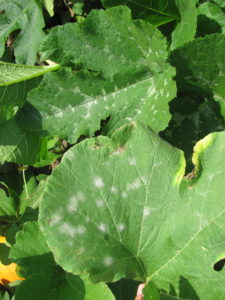Powdery mildew is a common disease of cucurbits in Indiana. This disease is more common on cantaloupe and pumpkin. However, we have observed powdery mildew more frequently on watermelon in recent years. We have also observed this disease on cucumber in high tunnels. If left uncontrolled, this disease can cause loss of foliage, loss of yield and lower quality fruit. This article will discuss the biology and management of powdery mildew of cucurbits.
Powdery mildew is relatively easy to recognize; talc-like lesions occur on both sides of the leaf (Figure 1). The fungus that causes powdery mildew, Podosphaera xanthii, does not require leaf wetness for infection of leaves, only high humidity. The optimum temperature for disease development is 68 to 81°F. P. xanthii may survive for a period in crop residue as a resilient fungal structure, but the disease is so easily windborne, that crop rotation is not always a practical control measure. The fungus that causes powdery mildew of cucurbits does not cause powdery mildew on other plant families. In the same way, powdery mildew of other plant families does not affect cucurbits.

Figure 1. The bottom pumpkin leaf has the disease powdery mildew. The top leaf is healthy and has a variegated pattern primarily along the veins.
Fortunately, commercial varieties of pumpkin, cantaloupe and cucumber exist with partial resistance to powdery mildew. Most growers, however, find it necessary to apply systemic fungicides to manage powdery mildew, even when using partially resistant varieties. As far as I know, there are no differences in the susceptibilities of watermelon varieties to powdery mildew.
To avoid additional sprays, cantaloupe, pumpkin and watermelon growers who are worried about powdery mildew and wish to apply fungicides may want to choose products that are effective on more diseases than just powdery mildew. For example, Luna Experience® should be effective on powdery mildew and gummy stem blight. Merivon® should be effective on anthracnose and powdery mildew. Aprovia Top® has proven effective on powdery mildew of cucurbits plus it is labeled on anthracnose and gummy stem blight. However, I don’t have any information about how effective Aprovia Top® is on the latter two diseases. Inspire Super®, may not be as effective as the products listed above on powdery mildew, however it should be effective against both anthracnose and gummy stem blight. Similarly, fungicides with the active ingredient tebuconazole (e.g., Monsoon®, Onset®, Toledo®, Vibe®) should have good efficacy against gummy stem blight and moderate efficacy against powdery mildew. For cucumber growers in high tunnels, Luna Experience®, Inspire Super® (label specifies cucumber only for greenhouse use), Monsoon®, Quintec® and Torino® are labeled for greenhouse use. Note that the use of Quintec® may result in a bit of leaf spotting in a greenhouse situation.
More information about powdery mildew management can be found in the Midwest Vegetable Production Guide 2018 mwveguide.org. Fungicide schedules for cantaloupe, watermelon and pumpkin can be found at purdue.ag/melonfs and purdue.ag/pumpkinfs. More information about powdery mildew can be found at https://vegcropshotline.org/article/powdery-mildew-of-cucurbits/. Information about organic powdery mildew control can be found at https://vegcropshotline.org/article/organic-powdery-mildew-control/. Finally, always read the label!